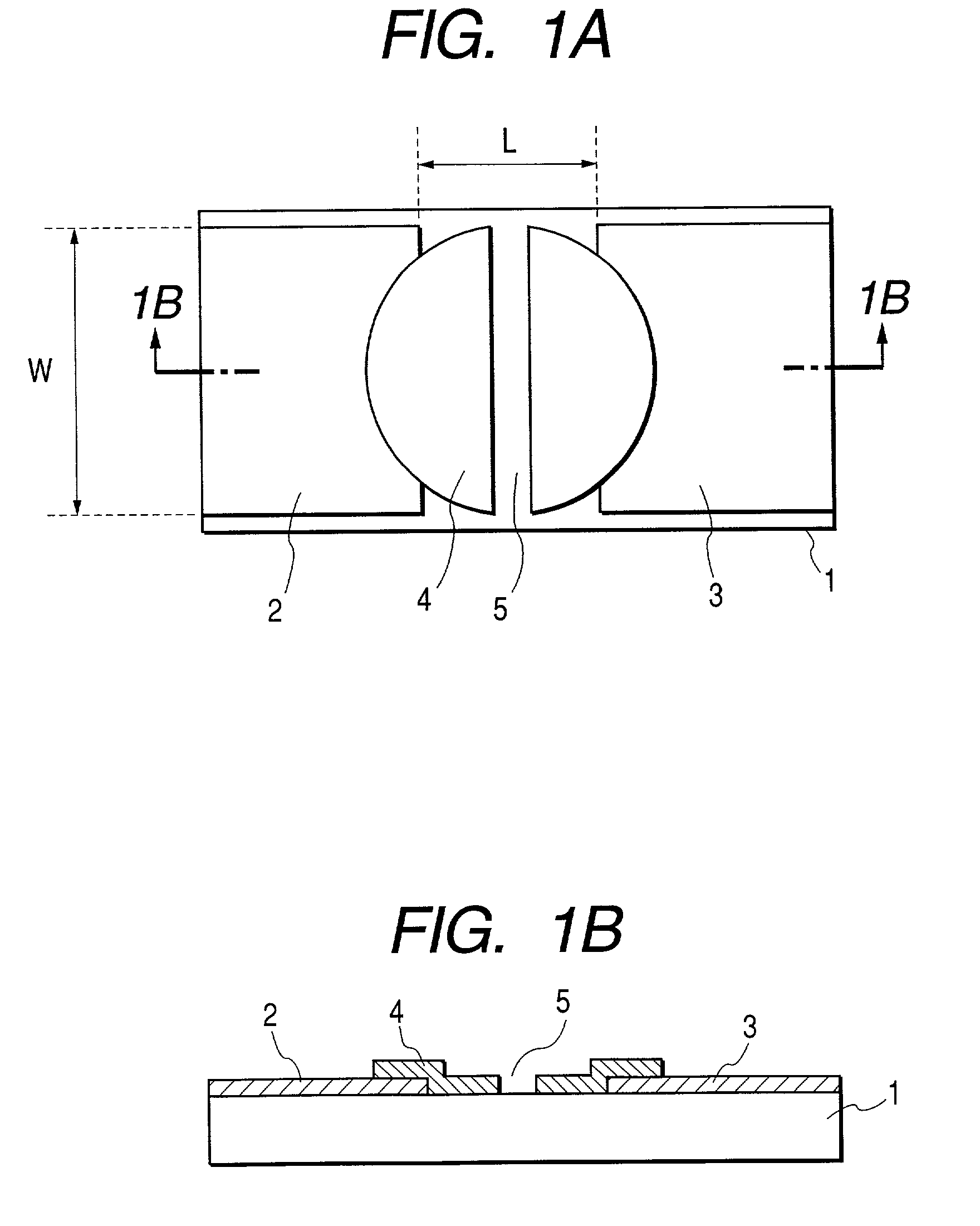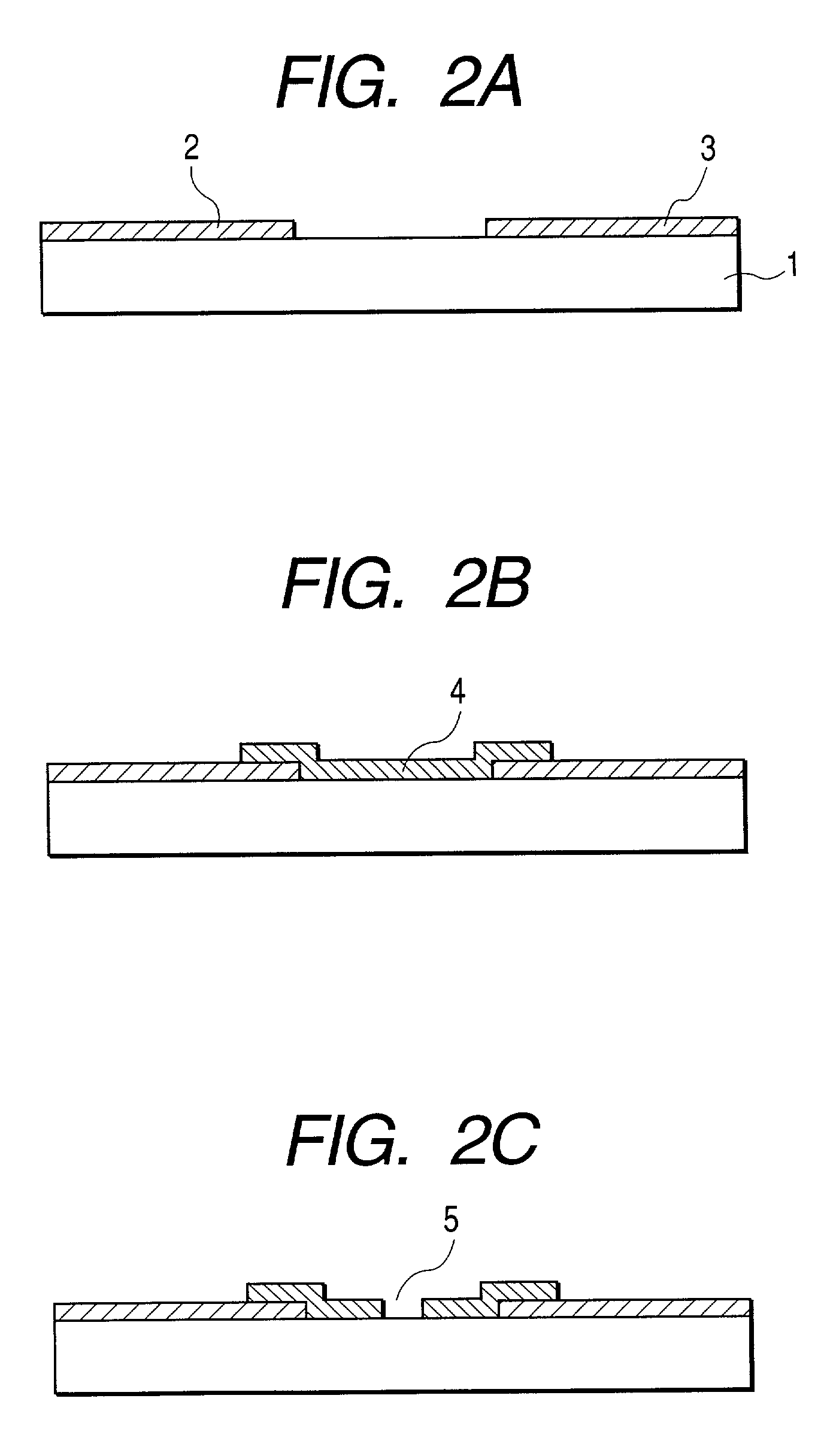Method for manufacturing image-forming apparatus involving changing a polymer film into an electroconductive film
- Summary
- Abstract
- Description
- Claims
- Application Information
AI Technical Summary
Benefits of technology
Problems solved by technology
Method used
Image
Examples
embodiment 1
[Embodiment 1]
[0102]As the electron-emitting device according to an embodiment 1, the electron-emitting device of type shown in FIGS. 1A and 1B was formed by using a method similar to the manufacturing method shown in FIGS. 2A to 2C. Now, the method for manufacturing the electron-emitting device according to the embodiment 1 will be described with reference to FIGS. 1A and 1B and FIGS. 2A to 2C.
[0103]A quartz glass substrate was used as the substrate 1, and the substrate 1 was fully cleaned by using pure water, organic solvent and the like. Thereafter, the device electrodes 2, 3 made of platinum were formed on the substrate 1 (FIG. 2A). In this case, a distance L between the device electrodes was selected to 10 μm, a width of the device electrode was selected to 500 μm and a thickness of the device electrode was selected to 100 μm.
[0104]Then, polyamic acid solution (PIX-L110; manufactured by Hitachi Kasei Co., Ltd.) as precursor for aromatic polyimide and solution diluted by N-methy...
embodiment 2
[Embodiment 2]
[0113]The electron-emitting device according to an embodiment 2 fundamentally has a configuration similar to that of the electron-emitting device of the embodiment 1.
[0114]Similar to the embodiment 1, N-methyl pyrrolidone / n-butyl Cellosolve solution of 3% of polyphenylenen hydrazide as precursor for polyphenylene oxisadiazol was rotary-coated on the quartz glass substrate on which the device electrodes 2, 3 formed from platinum were formed, manufactured in this way by means of a spin-coater. Then, a temperature was increased up to 310° C. under vacuum to effect baking, thereby obtaining polyphenylene oxisadiazol film having a thickness of 30 nm.
[0115]The polyphenylene oxisadiazol film was patterned to form a square configuration of 300 μm×300 μm straddling between the device electrodes 2 and 3 by a photolithography technique, thereby forming the polymer film having a desired configuration.
[0116]Then, after the electron beam was illuminated on the entire surface of the ...
embodiment 3
[Embodiment 3]
[0120]The electron-emitting device according to an embodiment 3 fundamentally has a configuration similar to that of the electron-emitting devices of the embodiments 1 and 2.
[0121]Similar to the embodiment 1, the quartz glass substrate 1 on which the device electrodes 2, 3 comprised of platinum and the polymer film 4 comprised of polyimide film were formed was set in a vacuum container to which an electronic gun was mounted and adequate air discharge was performed. Thereafter, bipolar rectangular pulses having voltage of 25 V, pulse width of 1 msec and pulse interval of 10 msec were applied between the device electrodes 2 and 3 while illuminating electron beam having acceleration voltage Vac of 7 kV and current density ρ of 0.1 mA / mm2 onto the whole surface of the polymer film 4. In this case, the current flowing between the device electrodes 2 and 3 was gradually increased, and, after the current was increased up to about 2.5 mA, since the current was suddenly decreas...
PUM
 Login to View More
Login to View More Abstract
Description
Claims
Application Information
 Login to View More
Login to View More - R&D
- Intellectual Property
- Life Sciences
- Materials
- Tech Scout
- Unparalleled Data Quality
- Higher Quality Content
- 60% Fewer Hallucinations
Browse by: Latest US Patents, China's latest patents, Technical Efficacy Thesaurus, Application Domain, Technology Topic, Popular Technical Reports.
© 2025 PatSnap. All rights reserved.Legal|Privacy policy|Modern Slavery Act Transparency Statement|Sitemap|About US| Contact US: help@patsnap.com



